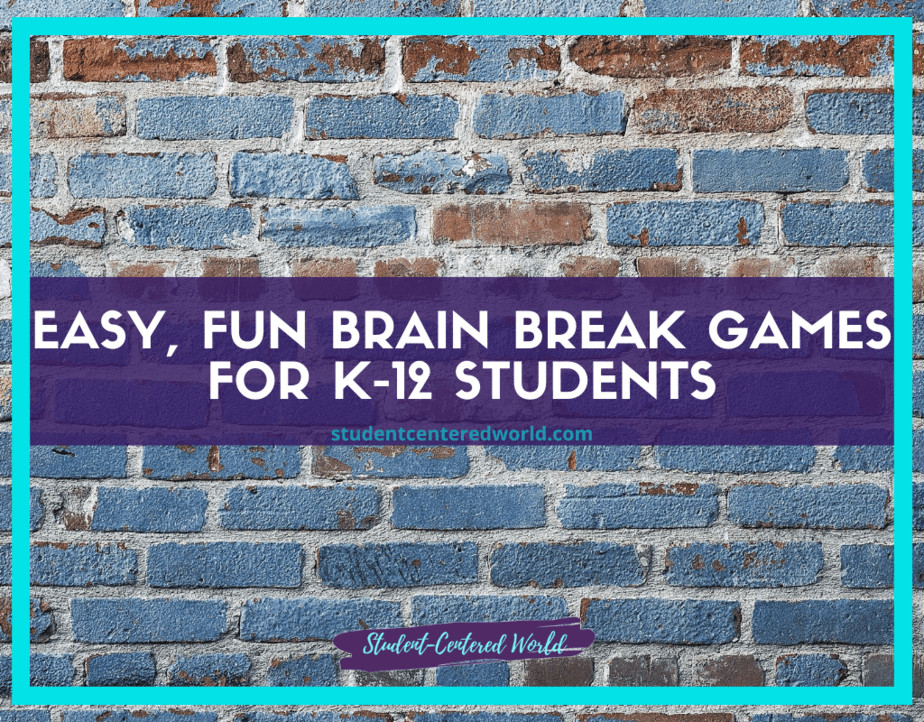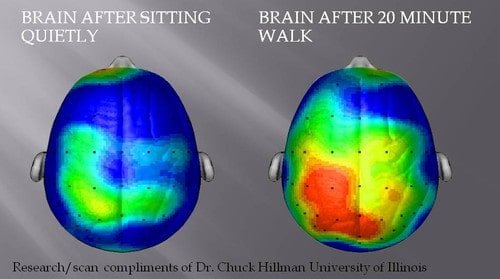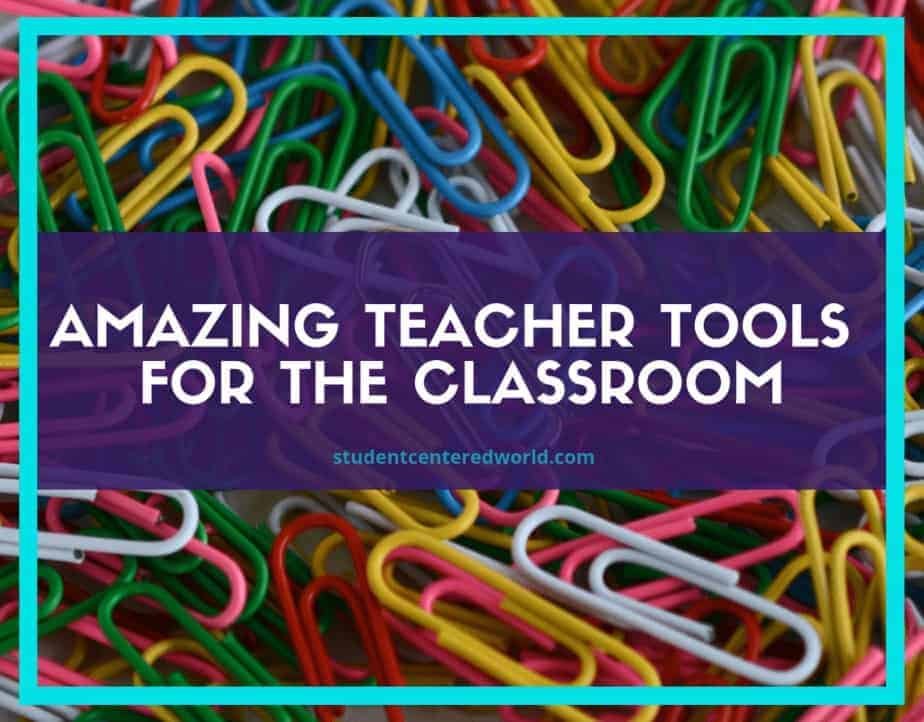Easy Brain Breaks for Kids in the 21st Century Classroom
Many people ask the question, “what are brain breaks in the classroom?” Brain breaks for kids in school give students (and teachers!) the opportunity to freshen their brains to prepare to excel more effectively. Research on brain breaks in the classroom shows that students who are taught these exercises do better long-term in their educational studies and have an easier time controlling stress and remaining mindful.
We’ve all been there…you’re just feeling off. You can’t concentrate. You have a deadline looming and you’re just muddling through to get it done, but you know it’s not your best work. No matter how hard you try to focus, your mind wanders and you just can’t seem to accomplish the things you have set out to do. You need a brain break, and there are plenty of options for brain breaks to choose from, especially brain breaks for kids.

(This post may contain affiliate links that won’t change your price but will share some commission. As an Amazon Associate, I earn from qualifying purchases. Please read our disclosure policy for more information.)
There are many different theories out there about how much time you need to take to do your best work. I once read that 52 minutes on and 17 minutes off is the most productive. You may be familiar with the Pomodoro Technique of productivity (ad). No matter what method you have heard of, one thing is the same across the board: it is documented that the human brain needs time to relax in order to perform at its best.
While workplaces are embracing this and adults regularly take the time to go grab a cup of coffee or take a quick lap around the office, often students are expected to stay put and do what is told of them with only a few passing minutes in between tasks.
Why do we expect our students needs to be any different than adults?? Brain breaks for kids are just as important.
One thing everyone needs to remember about student-centered learning is that the main goal is to help the student achieve at their highest attainable level. One thing everyone also needs to remember is that students are human, too. If it is commonplace for an adult to take a few minutes to collect themselves before moving forward with a task, why in the WORLD would we expect our students, whose brains are still developing, to be an exception to this norm? We must incorporate brain breaks for kids in the classroom.
What are brain breaks for kids?
Though the concept of brain breaks is quite the buzz these days, the question still often remains, “what is a brain break?”. Truly, this question is not archaic or a shock. The idea of taking brain breaks is not necessarily new, but it has not been widely accepted as a practice that takes place knowingly, especially in a classroom.
While adults will often take a quick walk, grab a coffee, etc. when they need to just get out for a few minutes, the idea of allowing age-appropriate experiences that are similar for our students has never really gone past a few minutes of recess. Fortunately, all that is changing.
Brain breaks for kids help and encourage a student to take some time when they need to become reinvigorated with the task at hand. With the attention span of our society shrinking from what it once was (it’s now roughly 8 seconds, in case you were wondering), it is necessary to help our students learn when they need to refocus. With a typical brain break only needing a few minutes of time, it is well worth the return in the long run.
Usually, there is a physical element to the brain break. As I mentioned, as an adult you may recognize when you need to take a quick walk to go run an errand to collect yourself. Since our students cannot readily go grab a cup of coffee, these moving elements need to be brought to their level with specific brain breaks for kids. It is something to have blood and oxygen circulating to their brain a bit more than if they were sitting stationary.
This may be something the whole class participates in (like brain break bingo) or just something that is available (like a coloring bulletin board). There are countless opportunities to engage in.
Again, it is best to know your students to know the most effective way to offer brain breaks for kids. It could be how you transition if you have students who struggle with that. It can be when things get too noisy. It could be when the energy level has dropped too much for productivity. It could be a combination. To put it simply, any time a student needs help focusing, a brain break is a perfect solution.
It’s odd because so many of us were taught that you need to sit down and pay attention. If you’re quiet, it means you are paying attention. The more we learn about the brain, especially the brain of a child (ad), we know that they simply don’t have the capacity to do this and they need to move. Instead of trying to require them to behave in a way that they are not naturally programmed for, why wouldn’t we come up with opportunities for them to learn what to do with that and actually gain the ability to focus in the meantime? Brain breaks for kids seem like the obvious answer.
You can also incorporate what it is that you are doing in class to the brain break for kids. In a high school math class, for instance, the students can complete some type of relay race when they solve the problem they just learned how to complete. In a kindergarten class, students can work with one another to create the letter of the alphabet with their bodies that they are learning. By moving and thinking at the same time, it helps to engage all areas of the brain. The activity does not necessarily need to be spelled out or structured, but just something that helps the students move and get the blood pumping a little bit.
I remember we used to play Simon Says in my seventh-grade English class all the time. We thought our teacher was just being fun. Little did we know there was science behind it. As tweens, we thought she was just “off on another one” whenever she would randomly announce, “Okay, everyone up! It’s time for Simon Says!”.
However, looking back now at the experience, it was exactly what we needed at that time. She knew how to implement brain breaks for kids before it was trendy. It was usually when our participation was less than stellar and our energy level was fading fast. It got us up and moving (much to our chagrin at times) and helped to zero back in on the task at hand. I have fond memories of that class and now realize my teacher was way ahead of her time.
It’s not just fluff, either. There is research that backs up the benefits of brain breaks for kids and it isn’t just from some quick classroom observations. In Andrew Thurston’s article Moving to Improve, he looks at several studies that show the benefits of students getting up and moving around and their concentration and productivity levels because of it. He also talks to several teachers who have effectively incorporated brain breaks for kids into their classrooms several times a day.
One key point that he notes is that even though most teachers recognize the importance of having students move (they’re supposed to get 60 minutes of activity a day, for goodness sake), many of them are afraid to incorporate brain breaks for kids due to the fear that it is an interruption and will lead to unnecessary disruption. This is purely a myth. With the correct implementation and knowledge on how to properly incorporate brain breaks, they are seamless and well received in the classroom (at any age).
So when someone wonders, “what is a brain break?” (ad), it’s an easy enough question to answer. A brain break helps a person to regain their focus by creating some type of movement that encourages blood flow and oxygen circulation. The outcomes from allowing these in the classroom way outweigh any detriment that they may cause and when executed directly lead to a seamless transition that helps on a number of levels.
To end with the same ending as in Thurston’s article, “It’s not going to interrupt your learning,” says Dultz. “It’s literally just a minute.” You can spare a minute for longer-term success, right? Good.
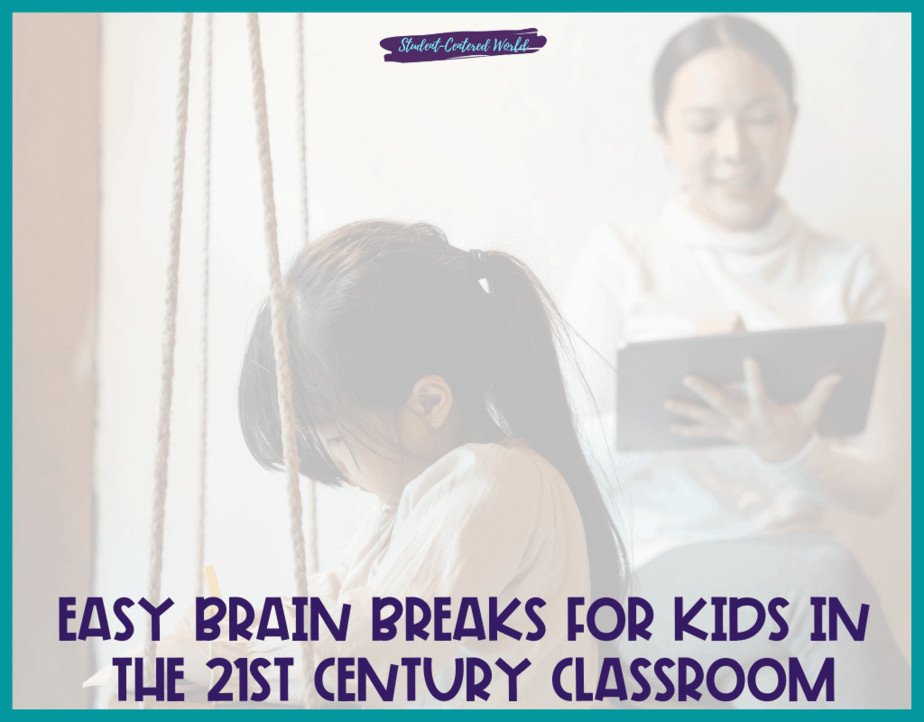
Why Do Students Need Brain Breaks?
The question, “Why do students need brain breaks?” is often accompanied by eye rolls and a general lack of understanding of why this is important. Over the years, the idea of how students were to behave in the classroom was relatively consistent. They come to school, sit down, are given information, and then they go home (where they are to practice that information).
Many people have the idea that kids should be able to sit still because kids years ago were, in fact, able to sit still. They would go to school they would complete the learning and they would come home. So why shouldn’t kids today be able to do so? The issue isn’t that inside school has changed, the problem is that outside school has changed.
By far, one of the best articles I have seen that breaks down this modern phenomenon is titled, Why So Many Kids Can’t Sit Still in School Today. In this article, authors Valerie Strauss and Angela Hanscom explain that students are coming to school ill-prepared to be able to focus because of their body structure.
Years ago when kids were in school they were playing, they were active they were spinning in circles and rolling down hills and climbing trees. To add to this issue, Hanscom explains, “Recess times have shortened due to increasing educational demands, and children rarely play outdoors due to parental fears, liability issues, and the hectic schedules of modern-day society. Let’s face it: Children are not nearly moving enough, and it is really starting to become a problem” and really helps hone in on why brain breaks for kids are so important.
Today, more and more kids are stationary and sitting in an upright position. With the rise of technology comes a decrease in child movement, and that literally makes their bodies physically unable to sit still. They are constantly wiggling and moving because they don’t have the appropriate muscle structure that supports sitting still for long periods of time. Couple that with the modern human’s attention span decreasing dramatically and you have a recipe for students who literally cannot sit still.
Why do we need brain breaks for kids? Because their bodies physically can’t handle NOT having them. Hanscom explains, “Ironically, many children are walking around with an underdeveloped vestibular (balance) system today–due to restricted movement. In order to develop a strong balance system, children need to move their bodies in all directions, for hours at a time.
Frequency of Brain Breaks for Kids
Just like with exercising, they need to do this more than just once a week in order to reap the benefits. Therefore, having soccer practice once or twice a week is likely not enough movement for the child to develop a strong sensory system.
Knowing this information makes a huge difference in the mentality of why brain breaks for kids matter. We now have a generation of students who come to school and they literally aren’t prepared to learn because their bodies aren’t physically able to do so. This is not their fault, nor does it make them less of a student than those in years past. They just are not being given the tools to make sure that they are able to learn to the best of their abilities.
So when asking the question of why students need brain breaks, the answer is clear. If we don’t get them moving around in the classroom, they simply are not going to learn at their best. Our job as teachers is to make sure not just that our students are learning, but they’re learning at their best if that means taking just a few minutes a couple of times a day to get them moving around, there’s no harm in that.
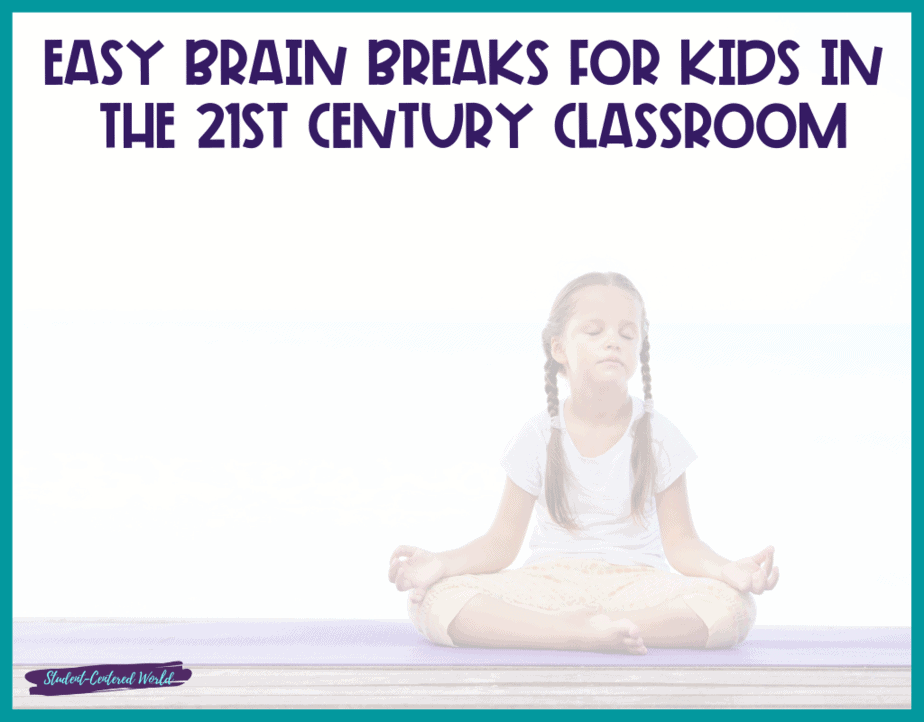
Incorporating Classroom Brain Breaks for Kids
Incorporating brain breaks for kids is not a difficult thing to do, it just takes a little bit of organization. There are several different ways that one can do this. It can be a full class activity at times where your students needed such as transitioning or when the energy level has just sunk.
It can also be individualized so students can get up and do something when they feel that they need to. It takes a little bit of time for them to learn how to police themselves, and off and it works better with older students (yes, even those in high school).
So what are some easy ideas to incorporate into a classroom (ad)? It can be something as time-tested as a quick game of Simon Says. You can incorporate something larger such as Brain Break Bingo. Another option that I love and this works at every grade level is you create a bulletin board in your classroom that is one giant page of coloring (ad). Students can get up when they need to and spend a couple of minutes filling in a part of the picture and then going back to their work.
When I personally started this in a lower-achieving high school, I was concerned that the students would take advantage of this opportunity as I’m sure most of you are thinking right now as you read this.
I was shocked to see that the students would go up to the board just when they needed to get up and move around a little bit take a couple of minutes and then police themselves enough to go and sit back down without any type of prompting from me.
There were some students that always started my class by taking a few minutes at that board. There were others that always ended the class that way. Gave them a little bit of choice at a moment to be able to collect themselves in a way that they did not have in other places. Creating an atmosphere where brain breaks for kids are commonplace is key.
Why Brain Breaks help Student Achievement
So why do students need Brain Breaks? Because if we want them to do their best in our classrooms, we need to give them the opportunities to move around. Not only do brain breaks for kids help circulate the blood and get the oxygen flowing to their brains, and also give them the opportunity to move that they aren’t necessarily taking outside of the classroom.
Don’t forget, our children are supposed to get 60 Minutes of physical activity a day. Are they really getting that? Sadly, most are not. Previous generations have, but we know that this generation is different. We need to make sure we are doing everything we can to give them all of the tools at their disposal to do well and to excel. Brain breaks are the perfect way to encourage this.
If anything, kids are more likely to struggle in areas requiring focus because they’re still learning how to deal with them. They’re still figuring out the necessary skills to be able to regroup and get their work done.
However, most teachers have been trained to believe that when a student walks through their door, they should be on their game from “bell to bell”. That’s really just not realistic without implementing brain breaks for kids.
I’m not saying that we should give these kids a pass. They need to learn how life works, and in life, you get your work done or the consequences are generally not in your favor. However, I am saying we should give them the tools to learn how to realistically deal with the times they’re just not “feeling it”.
Adding a Brain Break Opportunity
We all have coping mechanisms, also known as “brain breaks” where you give your brain a moment to settle down. Sometimes we listen to music, or go for a drive, or peruse the internet. It might be a snack or a walk, or playing with our pet. Obviously doing this in the classroom in a short period of time is not possible. There are small things that can be set up in a classroom to help these students take a moment and then get back to work.
When I created that “adult coloring book” bulletin board, I made several copies of a drawing that would look okay over and over again as a pattern and then put a basket of markers next to it. All students (high school students, mind you) were told that if they needed a brain break, they could go and color for a bit.
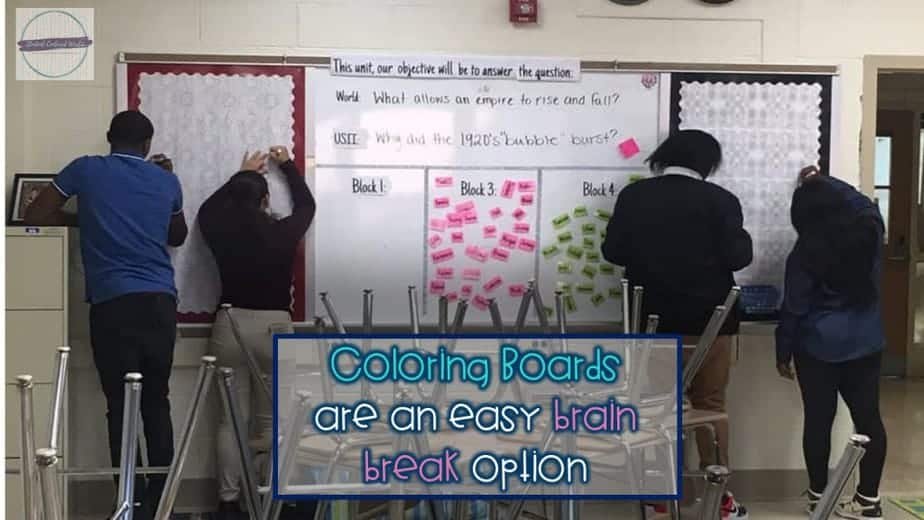
I was skeptical, anticipating having to talk to students about spending way too much time coloring. Honestly, I thought it wouldn’t work.
I was wrong.
Students took no more than 3 or 4 minutes to color at any given point.
I didn’t have the easiest group of kids in the world that were compliant with rules, either. But this gave them an outlet to give their brain a break and the ability to refocus.
No screens, no requirements, just a moment to catch their breath and regroup. A basic, simple brain break.
Boys, girls, overachievers, and those “too-cool-for-school” kids all took me up on this….and it’s COLORING. Who knew?!

Not only does this give your students the chance to increase their own productivity, but they are given the opportunity to regulate themselves and learn their exact needs in order to do their best work with these simple brain breaks for kids.
Will this always work perfectly? No. Of course, you may have students that try to work the system. Keep in mind though, most students who work the system are because they are the ones who are having trouble staying engaged.
Helping them especially learn how to take and use a brain break effectively may be a life skill that will help them throughout the rest of their lives.
It is such a simple idea, but it makes a huge difference in behavior and time management. Again, we should be helping our students develop skills that will help them throughout the rest of their lives, not just the minutes that are ticking until the end of their time in our classroom. By giving them the tools to learn their best, we are helping them much further than our curriculums are requiring, and that is the true meaning of education.
Think about your own classroom. What little corner can you transform into something that can give the students an opportunity to police themselves in a simple way, but also give them the space to breathe? Sometimes we all need a moment to get it together. Shouldn’t we allow our students the same opportunity? Creating brain breaks for kids is a perfect way.
Best Brain Breaks for Kids Ideas
There are still some people who believe that these silly little brain breaks are simply a waste of time. You can lay out a list of the best brain break ideas, and they still will turn their nose. The theory is one thing, but science is something different. Below is an MRI image of a brain that has been sitting versus one that was actively moving. The differences are staggering (click the picture to read the accompanying article):
You can see the areas of the brain that are activated after movement that is not when one is sitting quietly. As we’ve been mentioning throughout this brain break series, brain breaks allow for the blood to pump and oxygen flow to the brain to increase. This leads to higher levels of concentration and productivity in our students. It is important as the grown-ups in the room to remember this and encourage our students to partake in short bursts of activity that help them learn how to do this on their own.
When it comes to buy-in for brain breaks for kids, you really have to know your students to know what is going to work for them. A group of elementary students is much more likely to buy in quickly to the idea of a quick game in the classroom more so than a group of high school students.
That doesn’t mean it’s impossible, it just means you need to know what is going to work best for your students. Below you will find a generalized list with six of the best brain break ideas to try in your classroom. Again this is not an all-encompassing list and there are plenty of other brain breaks for kids’ ideas out there. this hopefully will be just a good jumping-off point for you as you start actively using brain breaks in your classroom.
Brain Break Bingo:
This particular activity is something that we designed at Student-Centered World to really help have students in the elementary and middle school levels buy into the concept of brain break activities. As they need a brain break, someone will pull a bingo piece from a jar and attach it to the bingo board where it corresponds.
Each piece is associated with different brain break activities that they will then complete.
When they complete bingo, they can pick from a larger activity that still constitutes as a brain break, such as a longer recess, a yoga session in the classroom, a dance party. or whatever else they choose to work towards.
This is a fun way to keep track of what is happening in your classroom and something for them to look forward to regularly in terms of brain breaks for kids.
Coloring Bulletin Boards:
These are great for any grade level. You will ultimately make copies of a page of an adult coloring book (ad) and cover your bulletin board in that photograph. The students will have the option to go up and color for a few moments when they need to to help regroup and focus.
Again, I was hesitant when I personally first tried this out in the high school classroom, but my students did not disappoint. They policed themselves and would go up to the board for just a few minutes, color in a spot, and would sit back down and get back to work.
Some students did this when they came into class to prepare themselves, others while class was going on, and yet others at the end of their time in class in preparation for the next place that they had to go. I never once had to reprimand a student for coloring for too long. This is, I feel, the best and easiest brain breaks for kids option.
Heads Up:
This is another fantastic game that you can play in lightning rounds and keep score over time, which adds a competitive element to it. The students can be broken up into teams which can be consistent if you’re keeping score or just groups that they put together. You can also play whole group; it really depends on the students in your classroom. (ad)
A student will hold up a card to his or her forehead that has a term on it and the rest of the students have to try to explain to them what is on that card without using the words that are given. If they’re able to guess what the other students are trying to tell them before the time runs out, then they receive a point.
You can certainly amend this to however it works in your classroom, but it certainly gets the kids up moving and often very loud which helps rejuvenate them when they need to be “jumpstarted”.
GoNoodle:
If you teach elementary and haven’t experienced GoNoodle, you’re missing out. GoNoodle is a fantastic option for younger students. You can play a variety of songs and dances and games that take just a few minutes to get through.
The kids absolutely love it.
There are also ways that you can incorporate curriculum when it comes to math reading and other such activities, which helps reinforce what you’re doing in the classroom and give them the opportunity to move around. I haven’t yet met one teacher that uses GoNoodle that has anything negative to say about it and all love it for brain breaks for kids (students included).
Pictionary:
This twist on a classic game is a great way to quickly review material and also get the students up and moving. A student will receive a term from their studies and then they have to try to draw it up on the board with the other students trying to guess what it is that they’re drawing.
This can also be broken up into smaller teams depending on the size of your classroom and points can be kept over long periods of time. It incorporates multiple things including the curriculum and the concept of the brain break which helps with all aspects of student well-being.
You can also just use the traditional form of Pictionary (ad) if you’re just looking for a way to take a moment away from the curriculum in your brain breaks for kids’ arsenal.
Whisper Down the Lane/Telephone:
If you are looking for calm-down brain breaks for kids, Whisper Down the Lane is always a fantastic option at any grade level. Students stand in line and the teacher (preferably) will think of a phrase that they will whisper to the first student who then has to whisper it to the person next to them and so on and so forth.
Nine out of ten times by the time it gets all the way to the end, the phrase is nowhere close to what the original phrase was; however, it gets the students calm and focused, but they’re having fun at the same time. It also brings forward a great lesson about how words could be misconstrued and changed depending on how many times a story is told there are a lot of benefits to playing this game, especially with a younger crowd.
Again, this is nothing more than six of the best brain breaks for kids’ ideas to use in your classroom. Hopefully, they are helping your wheels turn in thinking about what will work in YOUR classroom. Go have fun with it!
What have you done similar in the classroom? Feel free to comment and let others hear your great ideas!
Stop Driving the Teacher Struggle Bus
Are you struggling with student engagement, apathy, or keeping your class on track?
💫💫 There’s hope! 💫💫
Join my free teacher workshop “Choosing Choice” and in just 60 minutes, you’ll craft a practical plan to revitalize your teaching. Discover the magic of student choice in boosting engagement, gain quick implementation ideas, and explore strategies for year-long success.
Unlike overwhelming workshops, my approach guides you in real-time, providing more classroom options, reducing stress, and giving you more personal time.
Plus, you’ll earn a 1-hour professional development certificate and have 7 days of access.
Don’t miss this chance to transform your teaching; click below to secure your spot now!
